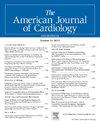Unmasking Myocardial Bridge–Related Ischemia by Quantitative Flow Ratio Functional Evaluation
IF 2.1
3区 医学
Q2 CARDIAC & CARDIOVASCULAR SYSTEMS
引用次数: 0
Abstract
A myocardial bridge (MB) is a condition where a segment of an epicardial coronary artery passes through the myocardial muscle. While traditionally regarded as benign, MBs have been associated with various cardiovascular conditions. Therefore, assessing their hemodynamic impact is crucial for informed treatment decisions. Intracoronary functional assessments, such as fractional flow reserve (FFR) and instantaneous wave-free ratio (iFR), have proven useful, especially under inotropic stimulation. However, their invasive nature limits their widespread clinical application. The Quantitative Flow Ratio (QFR) has emerged as a minimally invasive alternative for functional evaluation of MBs, though data on its use are still limited. This study aims to compare the diagnostic efficacy of FFR, iFR, and QFR for evaluating MBs both at rest and under stress conditions. Patients with confirmed MB on the LAD and typical angina (or abnormal noninvasive tests indicating myocardial ischemia) were included. According to a prespecified protocol, all patients underwent functional intracoronary evaluation with FFR and iFR at rest and after dobutamine and atropine intravenous infusion. QFR was also calculated for all cases both at rest and during dobutamine infusion. FFR values ≤0.80, iFR values ≤0.89 and QFR values ≤0.84 were considered indicative of significant myocardial ischemia. A total of 21 patients were included. Median FFR remained unchanged from rest (0.85) to stress (0.85), with only 1 patient showing a positive stress-FFR. In contrast, median iFR significantly decreased from 0.91 to 0.79 (p <0.001), with stress-iFR ≤0.89 in 18 patients. Resting QFR did not indicate significant hemodynamic impact of the MB (median 0.90), but under inotropic stimulation, ischemia was detected in 18 patients (median 0.79, p <0.001). QFR and iFR were concordant during stress in 19 patients, showing a significant positive correlation (Spearman’s ρ = 0.702, p = 0.037) and comparable sensitivity (0.86). QFR, computed during inotropic infusion, shows high sensitivity for detecting MB-related ischemia, comparable to stress-iFR and superior to stress-FFR. The correlation between stress-induced iFR and QFR suggests QFR as a reliable, minimally invasive alternative for functional lesion-specific evaluation in MB patients. Larger studies are necessary to confirm these preliminary findings and standardize QFR use in dynamic coronary stenosis assessments.
定量血流比功能评价揭示心肌桥相关性缺血。
心肌桥(MB)是一种心外膜冠状动脉的一段通过心肌的情况。虽然传统上被认为是良性的,但MBs与各种心血管疾病有关。因此,评估其血流动力学影响对明智的治疗决策至关重要。冠状动脉内功能评估,如分数血流储备(FFR)和瞬时无波比(iFR),已被证明是有用的,特别是在肌力刺激下。然而,其侵袭性限制了其广泛的临床应用。定量流量比(Quantitative Flow Ratio, QFR)已成为一种微创的mb功能评估替代方法,尽管有关其使用的数据仍然有限。本研究旨在比较FFR、iFR和QFR在静止和应激条件下评估MBs的诊断效果。方法:纳入LAD上确诊MB和典型心绞痛(或非侵入性检查异常提示心肌缺血)的患者。根据预先指定的方案,所有患者在静息时和多巴酚丁胺和阿托品静脉输注后进行功能性冠状动脉内FFR和iFR评估。还计算了所有病例在静息和多巴酚丁胺输注期间的QFR。FFR值≤0.80,iFR值≤0.89,QFR值≤0.84认为心肌缺血明显。结果:共纳入21例患者。中位FFR从休息(0.85)到应激(0.85)保持不变,只有1例患者表现出正的应激-FFR。相比之下,中位iFR从0.91显著下降到0.79 (p < 0.001),其中18例患者的应激-iFR≤0.89。静息QFR未显示MB对血流动力学的显著影响(中位数0.90),但在肌力刺激下,18例患者检测到缺血(中位数0.79,p < 0.001)。19例患者应激时QFR和iFR一致,呈显著正相关(Spearman ρ = 0.702,p = 0.037),敏感性比较(0.86)。结论:在肌力灌注过程中计算QFR对检测mb相关缺血具有很高的敏感性,与应激- ifr相当,优于应激- ffr。应激诱导的iFR和QFR之间的相关性表明,QFR是MB患者功能性病变特异性评估的可靠、微创替代方法。需要更大规模的研究来证实这些初步发现,并规范QFR在动态冠状动脉狭窄评估中的应用。
本文章由计算机程序翻译,如有差异,请以英文原文为准。
求助全文
约1分钟内获得全文
求助全文
来源期刊

American Journal of Cardiology
医学-心血管系统
CiteScore
4.00
自引率
3.60%
发文量
698
审稿时长
33 days
期刊介绍:
Published 24 times a year, The American Journal of Cardiology® is an independent journal designed for cardiovascular disease specialists and internists with a subspecialty in cardiology throughout the world. AJC is an independent, scientific, peer-reviewed journal of original articles that focus on the practical, clinical approach to the diagnosis and treatment of cardiovascular disease. AJC has one of the fastest acceptance to publication times in Cardiology. Features report on systemic hypertension, methodology, drugs, pacing, arrhythmia, preventive cardiology, congestive heart failure, valvular heart disease, congenital heart disease, and cardiomyopathy. Also included are editorials, readers'' comments, and symposia.
 求助内容:
求助内容: 应助结果提醒方式:
应助结果提醒方式:


